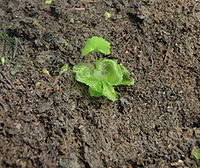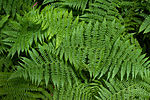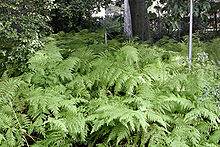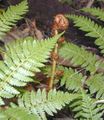- Fern
-
This article is about the group of pteridophyte plants. For other uses, see Fern (disambiguation).
Ferns (Pteridophyta)
Temporal range: Mid Devonian[1]—Recent
Athyrium filix-femina unrolling young frond Scientific classification Kingdom: Plantae Division: Pteridophyta Classes[2] - †Cladoxylopsida
- Psilotopsida
- Equisetopsida (alias Sphenopsida)
- Marattiopsida
- Polypodiopsida (alias Pteridopsida, Filicopsida)
- †Zygopteridales
- †Stauropteridales
- †Rhacophytales
A fern is any one of a group of about 12,000 species of plants belonging to the botanical group known as Pteridophyta.[3] Unlike mosses, they have xylem and phloem (making them vascular plants). They have stems, leaves, and roots like other vascular plants. Ferns reproduce via spores and have neither seeds nor flowers.
By far the largest group of ferns are the leptosporangiate ferns, but ferns as defined here (also called monilophytes) include horsetails, whisk ferns, marattioid ferns, and ophioglossoid ferns. The term pteridophyte also refers to ferns and a few other seedless vascular plants (see classification section below). A pteridologist is a specialist in the study of pteridophytes in a broader sense that includes the more distantly related lycophytes.
Ferns first appear in the fossil record 360 million years ago in the Carboniferous but many of the current families and species did not appear until roughly 145 million years ago in the late Cretaceous (after flowering plants came to dominate many environments).
Ferns are not of major economic importance, but some are grown or gathered for food, as ornamental plants, for remediating contaminated soils, and have been the subject of research for their ability to remove some chemical pollutants from the air. Some are significant weeds. They also play a role in mythology, medicine, and art.
Contents
Life cycle
Ferns are vascular plants differing from lycophytes by having true leaves (megaphylls). They differ from seed plants (gymnosperms and angiosperms) in their mode of reproduction—lacking flowers and seeds. Like all other vascular plants, they have a life cycle referred to as alternation of generations, characterized by a diploid sporophytic and a haploid gametophytic phase. The diploid sporophyte has 2n paired chromosomes, where n varies from species to species. The haploid gametophyte has n unpaired chromosomes, i.e. half the number of the sporophyte. Unlike the gymnosperms and angiosperms, the ferns' gametophyte is a free-living organism.
Life cycle of a typical fern:
- A diploid sporophyte phase produces haploid spores by meiosis (a process of cell division which reduces the number of chromosomes by a half).
- A spore grows into a haploid gametophyte by mitosis (a process of cell division which maintains the number of chromosomes). The gametophyte typically consists of a photosynthetic prothallus.
- The gametophyte produces gametes (often both sperm and eggs on the same prothallus) by mitosis.
- A mobile, flagellate sperm fertilizes an egg that remains attached to the prothallus.
- The fertilized egg is now a diploid zygote and grows by mitosis into a diploid sporophyte (the typical "fern" plant).
Fern ecology
The stereotypic image of ferns growing in moist shady woodland nooks is far from being a complete picture of the habitats where ferns can be found growing. Fern species live in a wide variety of habitats, from remote mountain elevations, to dry desert rock faces, to bodies of water or in open fields. Ferns in general may be thought of as largely being specialists in marginal habitats, often succeeding in places where various environmental factors limit the success of flowering plants. Some ferns are among the world's most serious weed species, including the bracken fern growing in the Scottish highlands, or the mosquito fern (Azolla) growing in tropical lakes, both species forming large aggressively spreading colonies. There are four particular types of habitats that ferns are found in: moist, shady forests; crevices in rock faces, especially when sheltered from the full sun; acid wetlands including bogs and swamps; and tropical trees, where many species are epiphytes (something like a quarter to a third of all fern species[4]).
Many ferns depend on associations with mycorrhizal fungi. Many ferns only grow within specific pH ranges; for instance, the climbing fern (Lygodium) of eastern North America will only grow in moist, intensely acid soils, while the bulblet bladder fern (Cystopteris bulbifera), with an overlapping range, is only found on limestone.
The spores are rich in lipids, protein and calories, so some vertebrates eat these. The European woodmouse (Apodemus sylvaticus) has been found to eat the spores of Culcita macrocarpa and the bullfinch (Pyrrhula murina) and the New Zealand lesser short-tailed bat (Mystacina tuberculata) also eat fern spores.[5]
Fern structure
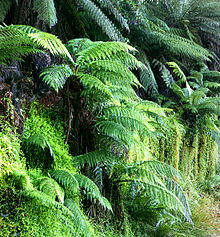 Tree ferns, probably Dicksonia antarctica, growing in Nunniong, Australia
Tree ferns, probably Dicksonia antarctica, growing in Nunniong, Australia
Like the sporophytes of seed plants, those of ferns consist of:
- Stems: Most often an underground creeping rhizome, but sometimes an above-ground creeping stolon (e.g., Polypodiaceae), or an above-ground erect semi-woody trunk (e.g., Cyatheaceae) reaching up to 20 m in a few species (e.g., Cyathea brownii on Norfolk Island and Cyathea medullaris in New Zealand).
- Leaf: The green, photosynthetic part of the plant. In ferns, it is often referred to as a frond, but this is because of the historical division between people who study ferns and people who study seed plants, rather than because of differences in structure. New leaves typically expand by the unrolling of a tight spiral called a crozier or fiddlehead. This uncurling of the leaf is termed circinate vernation. Leaves are divided into three types:
- Trophophyll: A leaf that does not produce spores, instead only producing sugars by photosynthesis. Analogous to the typical green leaves of seed plants.
- Sporophyll: A leaf that produces spores. These leaves are analogous to the scales of pine cones or to stamens and pistil in gymnosperms and angiosperms, respectively. Unlike the seed plants, however, the sporophylls of ferns are typically not very specialized, looking similar to trophophylls and producing sugars by photosynthesis as the trophophylls do.
- Brophophyll: A leaf that produces abnormally large amounts of spores. Their leaves are also larger than the other leaves but bear a resemblance to trophophylls.
- Roots: The underground non-photosynthetic structures that take up water and nutrients from soil. They are always fibrous and are structurally very similar to the roots of seed plants.
The gametophytes of ferns, however, are very different from those of seed plants. They typically consist of:
- Prothallus: A green, photosynthetic structure that is one cell thick, usually heart or kidney shaped, 3–10 mm long and 2–8 mm broad. The prothallus produces gametes by means of:
- Antheridia: Small spherical structures that produce flagellate sperm.
- Archegonia: A flask-shaped structure that produces a single egg at the bottom, reached by the sperm by swimming down the neck.
- Rhizoids: root-like structures (not true roots) that consist of single greatly elongated cells, water and mineral salts are absorbed over the whole structure. Rhizoids anchor the prothallus to the soil.
One difference between sporophytes and gametophytes might be summed up by the saying that "Nothing eats ferns, but everything eats gametophytes." This is an over-simplification, but it is true that gametophytes are often difficult to find in the field because they are far more likely to be food than are the sporophytes.
Evolution and classification
See also: List of fern familiesFerns first appear in the fossil record in the early-Carboniferous period. By the Triassic, the first evidence of ferns related to several modern families appeared. The "great fern radiation" occurred in the late-Cretaceous, when many modern families of ferns first appeared.
One problem with fern classification is the problem of cryptic species. A cryptic species is a species that is morphologically similar to another species, but differs genetically in ways that prevent fertile interbreeding. A good example of this is the currently designated species Asplenium trichomanes, the maidenhair spleenwort. This is actually a species complex that includes distinct diploid and tetraploid races. There are minor but unclear morphological differences between the two groups, which prefer distinctly differing habitats. In many cases such as this, the species complexes have been separated into separate species, thus raising the number of overall fern species. Possibly many more cryptic species are yet to be discovered and designated.
Ferns have traditionally been grouped in the Class Filices, but modern classifications assign them their own phylum or division in the plant kingdom, called Pteridophyta, also known as Filicophyta. The group is also referred to as Polypodiophyta, (or Polypodiopsida when treated as a subdivision of tracheophyta (vascular plants), although Polypodiopsida sometimes refers to only the leptosporangiate ferns). The term "pteridophyte" has traditionally been used to describe all seedless vascular plants, making it synonymous with "ferns and fern allies". This can be confusing since members of the fern phylum Pteridophyta are also sometimes referred to as pteridophytes. The study of ferns and other pteridophytes is called pteridology, and one who studies ferns and other pteridophytes is called a pteridologist.
Traditionally, three discrete groups of plants have been considered ferns: two groups of eusporangiate ferns—families Ophioglossaceae (adders-tongues, moonworts, and grape-ferns) and Marattiaceae—and the leptosporangiate ferns. The Marattiaceae are a primitive group of tropical ferns with a large, fleshy rhizome, and are now thought to be a sibling taxon to the main group of ferns, the leptosporangiate ferns. Several other groups of plants were considered "fern allies": the clubmosses, spikemosses, and quillworts in the Lycopodiophyta, the whisk ferns in Psilotaceae, and the horsetails in the Equisetaceae. More recent genetic studies have shown that the Lycopodiophyta are more distantly related to other vascular plants, having radiated evolutionarily at the base of the vascular plant clade, while both the whisk ferns and horsetails are as much "true" ferns as are the Ophioglossoids and Marattiaceae. In fact, the whisk ferns and Ophioglossoids are demonstrably a clade, and the horsetails and Marattiaceae are arguably another clade. Molecular data—which remain poorly constrained for many parts of the plants' phylogeny — have been supplemented by recent morphological observations supporting the inclusion of Equisetaceae within the ferns, notably relating to the construction of their sperm, and peculiarities of their roots.[2] However, there are still differences of opinion about the placement of the Equisetum species (see Equisetopsida for further discussion). One possible means of treating this situation is to consider only the leptosporangiate ferns as "true" ferns, while considering the other three groups as "fern allies". In practice, numerous classification schemes have been proposed for ferns and fern allies, and there has been little consensus among them.
A 2006 classification by Smith et al. is based on recent molecular systematic studies, in addition to morphological data. Their phylogeny is a consensus of a number of studies, and is shown below (to the level of orders).[2]
Trachaeophyta euphyllophytes ferns Psilotopsida Psilotales
Equisetopsida Marattiopsida Marattiales
Polypodiopsida Osmundales
Hymenophyllales
Gleicheniales
core
leptosporangiatesTheir classification based on this phylogeny divides extant ferns into four classes:
- Psilotopsida (whisk ferns and ophioglossoid ferns), about 92 species[6]
- Equisetopsida (horsetails), about 15 species[6]
- Marattiopsida, about 150 species[6]
- Polypodiopsida (leptosporangiate ferns), over 9000 species[6]
The last group includes most plants familiarly known as ferns. Modern research supports older ideas based on morphology that the Osmundaceae diverged early in the evolutionary history of the leptosporangiate ferns; in certain ways this family is intermediate between the eusporangiate ferns and the leptosporangiate ferns.
Uses
Ferns are not as important economically as seed plants but have considerable importance in some societies. Some ferns are used for food, including the fiddleheads of bracken, Pteridium aquilinum, ostrich fern, Matteuccia struthiopteris, and cinnamon fern, Osmunda cinnamomea. Diplazium esculentum is also used by some tropical peoples as food. Tubers from the King Fern or para (Ptisana salicina) are a traditional food in New Zealand and the South Pacific. Fern tubers were used for food 30,000 years ago in Europe.[7][8] Fern tubers were used by the Guanches to make gofio in the Canary Islands. Licorice fern rhizomes were chewed by the natives of the Pacific Northwest for their flavor.[citation needed]
Ferns of the genus Azolla are very small, floating plants that do not resemble ferns. Called mosquito fern, they are used as a biological fertilizer in the rice paddies of southeast Asia, taking advantage of their ability to fix nitrogen from the air into compounds that can then be used by other plants.[citation needed]
Many ferns are grown in horticulture as landscape plants, for cut foliage and as houseplants, especially the Boston fern (Nephrolepis exaltata) and other members of the genus Nephrolepis. The Bird's Nest Fern (Asplenium nidus) is also popular, as is the staghorn ferns (genus Platycerium). Perennial (also known as hardy) ferns planted in gardens in the northern hemisphere also have a considerable following.[citation needed]
Several ferns are noxious weeds or invasive species, including Japanese climbing fern (Lygodium japonicum), mosquito fern and sensitive fern (Onoclea sensibilis). Giant water fern (Salvinia molesta) is one of the world's worst aquatic weeds. The important fossil fuel coal consists of the remains of primitive plants, including ferns.[citation needed]
Ferns have been studied and found to be useful in the removal of heavy metals, especially arsenic, from the soil. Other ferns with some economic significance include:[citation needed]
- Dryopteris filix-mas (male fern), used as a vermifuge, and formerly in the US Pharmacopeia; also, this fern accidentally sprouting in a bottle resulted in Nathaniel Bagshaw Ward's 1829 invention of the terrarium or Wardian case
- Rumohra adiantiformis (floral fern), extensively used in the florist trade
- Microsorum pteropus (Java fern), one of the most popular freshwater aquarium plants.
- Osmunda regalis (royal fern) and Osmunda cinnamomea (cinnamon fern), the root fiber being used horticulturally; the fiddleheads of O. cinnamomea are also used as a cooked vegetable
- Matteuccia struthiopteris (ostrich fern), the fiddleheads used as a cooked vegetable in North America
- Pteridium aquilinum or Pteridium esculentum (bracken), the fiddleheads used as a cooked vegetable in Japan and are believed to be responsible for the high rate of stomach cancer in Japan. It is also one of the world's most important agricultural weeds, especially in the British highlands, and often poisons cattle and horses.
- Diplazium esculentum (vegetable fern), a source of food for some native societies
- Pteris vittata (brake fern), used to absorb arsenic from the soil
- Polypodium glycyrrhiza (licorice fern), roots chewed for their pleasant flavor
- Tree ferns, used as building material in some tropical areas
- Cyathea cooperi (Australian tree fern), an important invasive species in Hawaii
- Ceratopteris richardii, a model plant for teaching and research, often called C-fern
Cultural connotations
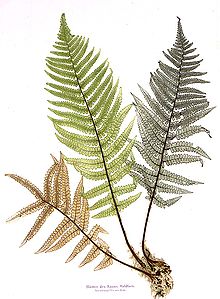 Blätter des Manns Walfarn. by Alois Auer, Vienna: Imperial Printing Office, 1853
Blätter des Manns Walfarn. by Alois Auer, Vienna: Imperial Printing Office, 1853
Ferns figure in folklore, for example in legends about mythical flowers or seeds.[9] In Slavic folklore, ferns are believed to bloom once a year, during the Ivan Kupala night. Although alleged to be exceedingly difficult to find, anyone who sees a "fern flower" is thought to be guaranteed to be happy and rich for the rest of their life. Similarly, Finnish tradition holds that one who finds the "seed" of a fern in bloom on Midsummer night will, by possession of it, be guided and be able to travel invisibly to the locations where eternally blazing Will o' the wisps called aarnivalkea mark the spot of hidden treasure. These spots are protected by a spell that prevents anyone but the fern-seed holder from ever knowing their locations.[10]
"Pteridomania"' is a term for the Victorian era craze of fern collecting and fern motifs in decorative art including pottery, glass, metals, textiles, wood, printed paper, and sculpture "appearing on everything from christening presents to gravestones and memorials." The fashion for growing ferns indoors led to the development of the Wardian case, a glazed cabinet that would exclude air pollutants and maintain the necessary humidity.[11]
The dried form of ferns was also used in other arts, being used as a stencil or directly inked for use in a design. The botanical work, The Ferns of Great Britain and Ireland, is a notable example of this type of nature printing. The process, patented by the artist and publisher Henry Bradbury, impressed a specimen on to a soft lead plate. The first publication to demonstrate this was Alois Auer's The Discovery of the Nature Printing-Process.
Misunderstood names
Several non-fern plants are called "ferns" and are sometimes confused with true ferns. These include:
- "Asparagus fern"—This may apply to one of several species of the monocot genus Asparagus, which are flowering plants.
- "Sweetfern"—A flowering shrub of the genus Comptonia.
- "Air fern"—A group of animals called hydrozoan that are distantly related to jellyfish and corals. They are harvested, dried, dyed green, and then sold as a "plant" that can "live on air". While it may look like a fern, it is merely the skeleton of this colonial animal.
- "Fern bush"—Chamaebatiaria millefolium—a rose family shrub with fern-like leaves.
In addition, the book Where the Red Fern Grows has elicited many questions about the mythical "red fern" named in the book. There is no such known plant, although there has been speculation that the oblique grape-fern, Sceptridium dissectum, could be referred to here, because it is known to appear on disturbed sites and its fronds may redden over the winter.
Gallery
-
"Filicinae" from Ernst Haeckel's Kunstformen der Natur, 1904
-
Ferns in one of many natural Coast Redwood undergrowth settings Santa Cruz, CA.
-
Nature prints in The Ferns of Great Britain and Ireland used fronds to produce the plates
-
Fern bed under a forest canopy in woods near Franklin, Virginia
See also
- Fern gall
- Fern spike
- Fern sports
- Fiddlehead greens
- Pteridomania
References
- ^ Wattieza, Stein, W. E., F. Mannolini, L. V. Hernick, E. Landling, and C. M. Berry. 2007. "Giant cladoxylopsid trees resolve the enigma of the Earth's earliest forest stumps at Gilboa", Nature (19 April 2007) 446:904–907.
- ^ a b c Smith, A.R.; Pryer, K.M.; Schuettpelz, E.; Korall, P.; Schneider, H.; Wolf, P.G. (2006). "A classification for extant ferns". Taxon 55 (3): 705–731. doi:10.2307/25065646. JSTOR 25065646. http://www.pryerlab.net/publication/fichier749.pdf. Retrieved 2008-02-12.
- ^ Chapman, Arthur D. (2009). Numbers of Living Species in Australia and the World. Report for the Australian Biological Resources Study. Canberra, Australia. September 2009. http://www.environment.gov.au/biodiversity/abrs/publications/other/species-numbers/index.html
- ^ Schuettpelz, Eric. "Fern Phylogeny Inferred from 400 Leptosporangiate Species and Three Plastid Genes," contained in "The Evolution and Diversification of Epiphytic Ferns." Doctoral dissertation, Duke University. 2007. http://dukespace.lib.duke.edu/dspace/bitstream/10161/181/1/D_Schuettpelz_Eric_a_052007.pdf
- ^ Walker, Matt (19 February 2010). "A mouse that eats ferns like a dinosaur". BBC Earth News. http://news.bbc.co.uk/earth/hi/earth_news/newsid_8523000/8523825.stm. Retrieved 20 February 2010.
- ^ a b c d Eric Schuettpelz (2007). "table 1". The evolution and diversification of epiphytic ferns. Duke University PhD thesis. http://dukespace.lib.duke.edu/dspace/bitstream/10161/181/1/D_Schuettpelz_Eric_a_052007.pdf
- ^ "Stone Age humans liked their burgers in a bun", Sonia Van Gilder Cooke, New Scientist, 23 Oct. 2010, p. 18.
- ^ "Thirty thousand-year-old evidence of plant food processing" by Anna Revedin et al., PNAS, published online Oct. 18, 2010.
- ^ May, Lenore Wile (1978). "The economic uses and associated folklore of ferns and fern allies". The Botanical Review 44 (4): 491–528. doi:10.1007/BF02860848
- ^ http://www.saunalahti.fi/~marian1/gourmet/season5a.htm
- ^ * Boyd, Peter D. A. (2002-01-02). Pteridomania - the Victorian passion for ferns. Revised: web version. Antique Collecting 28, 6, 9–12.. http://www.peterboyd.com/pteridomania.htm. Retrieved 2007-10-02.
- Pryer, Kathleen M., Harald Schneider, Alan R. Smith, Raymond Cranfill, Paul G. Wolf, Jeffrey S. Hunt and Sedonia D. Sipes. 2001. Horsetails and ferns are a monophyletic group and the closest living relatives to seed plants. Nature 409: 618–622 (abstract here).
- Pryer, Kathleen M., Eric Schuettpelz, Paul G. Wolf, Harald Schneider, Alan R. Smith and Raymond Cranfill. 2004. Phylogeny and evolution of ferns (monilophytes) with a focus on the early leptosporangiate divergences. American Journal of Botany 91:1582–1598 (online abstract here).
- Moran, Robbin C. (2004). A Natural History of Ferns. Portland, OR: Timber Press. ISBN 0-88192-667-1.
- Lord, Thomas R. (2006). Ferns and Fern Allies of Pennsylvania. Indiana, PA: Pinelands Press. [1]
External links
- Tree of Life Web Project: Filicopsida
- A classification of the ferns and their allies
- A fern book bibliography
- Register of fossil Pteridophyta
- L. Watson and M.J. Dallwitz (2004 onwards). The Ferns (Filicopsida) of the British Isles.
- Ferns and Pteridomania in Victorian Scotland
- Non-seed plant images at bioimages.vanderbilt.edu
- "American Fern Society"
- "British Pteridological Society"
- Checklist of Ferns and Lycophytes of the World
Botany Subdisciplines of botany Ethnobotany · Paleobotany · Plant anatomy · Plant ecology · Plant evo-devo · Plant morphology · Plant physiology
Plants Plant parts Plant cells Plant reproduction Plant taxonomy Glossaries Category · PortalClassification of Archaeplastida / Plantae sensu lato Rhodophyta Cyanidiophyceae · Porphyridiophyceae · Compsopogonophyceae · Stylonematophyceae · Rhodellophyceae · Bangiophyceae · Florideophyceae (Hildenbrandiales, Acrochaetiales, Nemaliales, Batrachospermales, Corallinales, Gelidiales, Gracilariales, Ceramiales)Glaucocystophyceae Glaucocystis · Cyanophora · GloeochaeteViridiplantae/
Plantae
sensu strictoEuphyllophytaMoniliformopses (Equisetopsida, Filicopsida, Psilotopsida)
Spermatophyta: Gymnosperm (Pinophyta, Cycadophyta, Ginkgophyta, Gnetophyta) · MagnoliophytaSee also: list of plant ordersCategories:- Pteridophyta
- Fern florae
Wikimedia Foundation. 2010.

